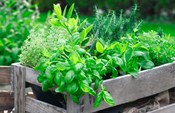Last week, I used fresh dill weed in a recipe for the first time and was surprised how mild it was -- very different from the dried dill I normally use. I want to try using more fresh herbs. Any ideas on where I should start?
Sure. But you should know that the first rule of cooking with fresh herbs is this: There are no rules. Have fun and experiment, using small amounts at first as you figure out what you like.
Using herbs is a great way to add rich flavor to foods. They are often touted as alternatives to salt, which is linked to an increased risk of high blood pressure, but they can also add zest when you reduce sugar or fat in a recipe.
Ohio State University Extension has a free fact sheet, “Selecting, Storing and Using Fresh Herbs,” available to download at http://go.osu.edu/ohiolineherbs. Some of the advice it offers includes:
- Handle fresh herbs gently. Oils that give herbs their aroma and flavor readily escape from the leaves, seeds and stems if they’re injured.
- If you have more of an herb than what you can use immediately, you can store it in the refrigerator for a week or more by trimming off the ends of the stems on the diagonal and putting them upright in a tall glass or vase with an inch of water. Cover it loosely with a plastic bag, allowing air to circulate. Change the water daily.
- Extended cooking will weaken the flavor of fresh herbs, so for soups or stews, add them in the last 45 minutes of cooking. On the other hand, in cold foods such as dips, dressings, cheeses or cold vegetables, add fresh herbs several hours or overnight before serving.
- If you’re not familiar with the flavor of a new herb, mix it with margarine or butter and let it set for about an hour. Then spread it on a plain cracker to taste.
The fact sheet also lists some popular fresh herbs, from anise to thyme, and suggests dishes to try them in.
The Academy of Nutrition and Dietetics also has some tips in an online slide show, “Flavor Your Meals: Must-Have Summer Herbs,” at http://bit.ly/flavorherbs. It offers information on using both favorite and uncommon fresh herbs, including rosemary, mint, basil, dill, oregano, cilantro, bee balm, chives, lavender and lemon verbena.
Another good reference on using fresh herbs (and, actually, for all things culinary) is the book “The New Food Lover’s Companion” by Sharon Tyler Herbst and Ron Herbst. It has thousands of entries on foods and cooking techniques, as well as herbs and spices. Take a look -- you might be surprised at what you don’t know.







